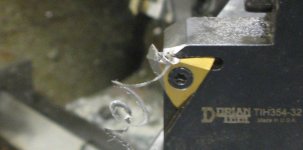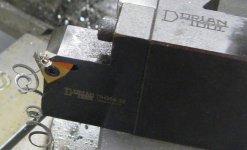haven't had this problem before,and yes
1)I cut 304ss/316SS for 20 years and
2)I'm using the compound to move in at 29 degrees/ only cutting on 1 side of tool.
3)I'm taking very small cuts,like .002 at a time,but I'm in pretty far so it's a pretty wide cut for 8 TPI.
It seems to cut fine sometimes,then with no warning this happens. (material is jammed against holder and cold-welded to the insert. ( I can hear the lathe struggling so i back the tool out immediately,and that has saved the inserts ,just not my nerves.
oil or coolant,not much difference (coolant slightly better).
Anyone recommend a better tool? This is the TNMC-32nv,it is rated for 6 to 36 tpi pitch range. The chip is getting pushed back and under that shoulder that juts out over the insert. Once that happens, it has nowhere to go and builds up on top of the insert. It's an old tool,and I'm guessing there are better tools out there
thanks for any advice
1)I cut 304ss/316SS for 20 years and
2)I'm using the compound to move in at 29 degrees/ only cutting on 1 side of tool.
3)I'm taking very small cuts,like .002 at a time,but I'm in pretty far so it's a pretty wide cut for 8 TPI.
It seems to cut fine sometimes,then with no warning this happens. (material is jammed against holder and cold-welded to the insert. ( I can hear the lathe struggling so i back the tool out immediately,and that has saved the inserts ,just not my nerves.
oil or coolant,not much difference (coolant slightly better).
Anyone recommend a better tool? This is the TNMC-32nv,it is rated for 6 to 36 tpi pitch range. The chip is getting pushed back and under that shoulder that juts out over the insert. Once that happens, it has nowhere to go and builds up on top of the insert. It's an old tool,and I'm guessing there are better tools out there
thanks for any advice





